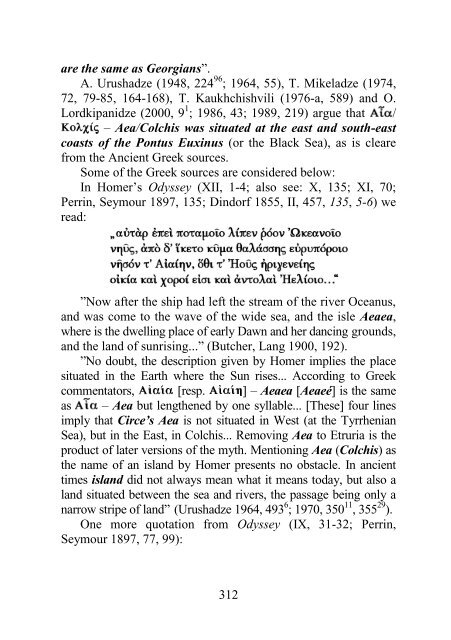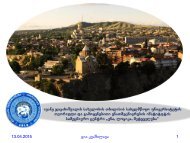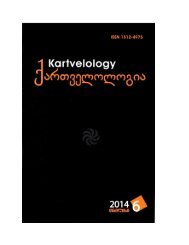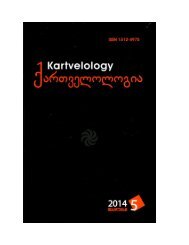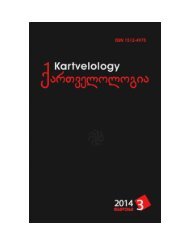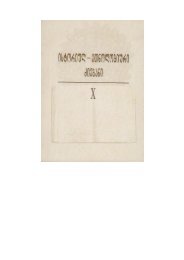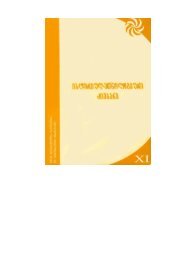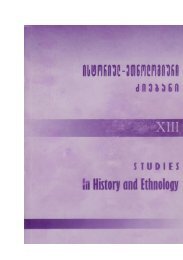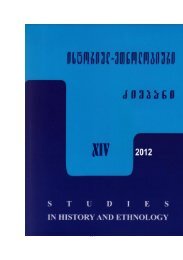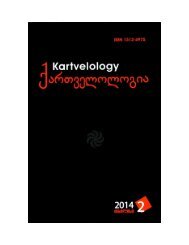Kvashilava, Gia, 2010. On Reading Pictorial Signs of the Phaistos Disk and Related Scripts (2). Rosette (in Georgian and English)
This study concerns the graphic character, symbolic meanings, typological parallels, commentaries and reading of the Phaistos Disk pictorial sign PHD38.
This study concerns the graphic character, symbolic meanings, typological parallels, commentaries and reading of the Phaistos Disk pictorial sign PHD38.
Create successful ePaper yourself
Turn your PDF publications into a flip-book with our unique Google optimized e-Paper software.
are <strong>the</strong> same as <strong>Georgian</strong>s”.<br />
A. Urushadze (1948, 224 96 ; 1964, 55), T. Mikeladze (1974,<br />
72, 79-85, 164-168), T. Kaukhchishvili (1976-a, 589) <strong>and</strong> O.<br />
Lordkipanidze (2000, 9 1 ; 1986, 43; 1989, 219) argue that /<br />
– Aea/Colchis was situated at <strong>the</strong> east <strong>and</strong> south-east<br />
coasts <strong>of</strong> <strong>the</strong> Pontus Eux<strong>in</strong>us (or <strong>the</strong> Black Sea), as is cleare<br />
from <strong>the</strong> Ancient Greek sources.<br />
Some <strong>of</strong> <strong>the</strong> Greek sources are considered below:<br />
In Homer‟s Odyssey (XII, 1-4; also see: X, 135; XI, 70;<br />
Perr<strong>in</strong>, Seymour 1897, 135; D<strong>in</strong>dorf 1855, II, 457, 135, 5-6) we<br />
read:<br />
”Now after <strong>the</strong> ship had left <strong>the</strong> stream <strong>of</strong> <strong>the</strong> river Oceanus,<br />
<strong>and</strong> was come to <strong>the</strong> wave <strong>of</strong> <strong>the</strong> wide sea, <strong>and</strong> <strong>the</strong> isle Aeaea,<br />
where is <strong>the</strong> dwell<strong>in</strong>g place <strong>of</strong> early Dawn <strong>and</strong> her danc<strong>in</strong>g grounds,<br />
<strong>and</strong> <strong>the</strong> l<strong>and</strong> <strong>of</strong> sunris<strong>in</strong>g...” (Butcher, Lang 1900, 192).<br />
”No doubt, <strong>the</strong> description given by Homer implies <strong>the</strong> place<br />
situated <strong>in</strong> <strong>the</strong> Earth where <strong>the</strong> Sun rises... Accord<strong>in</strong>g to Greek<br />
commentators, [resp. ] – Aeaea [Aeaeé] is <strong>the</strong> same<br />
as – Aea but leng<strong>the</strong>ned by one syllable... [These] four l<strong>in</strong>es<br />
imply that Circe’s Aea is not situated <strong>in</strong> West (at <strong>the</strong> Tyrrhenian<br />
Sea), but <strong>in</strong> <strong>the</strong> East, <strong>in</strong> Colchis... Remov<strong>in</strong>g Aea to Etruria is <strong>the</strong><br />
product <strong>of</strong> later versions <strong>of</strong> <strong>the</strong> myth. Mention<strong>in</strong>g Aea (Colchis) as<br />
<strong>the</strong> name <strong>of</strong> an isl<strong>and</strong> by Homer presents no obstacle. In ancient<br />
times isl<strong>and</strong> did not always mean what it means today, but also a<br />
l<strong>and</strong> situated between <strong>the</strong> sea <strong>and</strong> rivers, <strong>the</strong> passage be<strong>in</strong>g only a<br />
narrow stripe <strong>of</strong> l<strong>and</strong>” (Urushadze 1964, 493 6 ; 1970, 350 11 , 355 29 ).<br />
<strong>On</strong>e more quotation from Odyssey (IX, 31-32; Perr<strong>in</strong>,<br />
Seymour 1897, 77, 99):<br />
312


